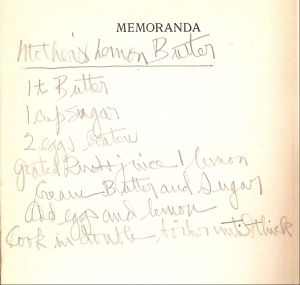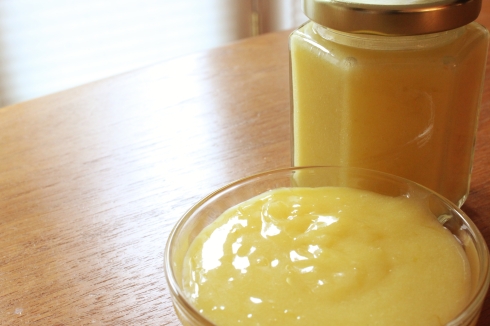You are currently browsing the tag archive for the ‘elegant’ tag.
When I first read this — in Grammy’s scrawl in her “Guests and Menus” book — I thought I was looking at a bad spelling of “creme brulee,” the creamy custard with a crunchy browned-sugar crust. I was not. The French verb “brouiller,” to mix up or to scramble, has nothing to do with blowtorches and caramelizing sugar. It has everything to do with creating a mind-blowingly rich pudding of mixed-up cream and eggs.
Grammy got her “Guests and Menus” book in 1974; my parents brought the red, pebbled-leather volume back from London. By then, Grammy was 74 and had been widowed for a decade. Did that cramp her entertaining style? Not at all. The table-layouts in the book show dinners for 14 or 16, luncheons for 10, cocktail parties for dozens.
This dessert was listed several times on the “menus” side of the page. After making it, I can see why: It is dead easy, yet tastes complicated, rich and fancy.
Think ice cream — but not cold. Or vanilla pudding — but no actual vanilla in there. You end up with a pudding topped with sliced or mashed fruit. As you serve the pudding — particularly if you’re using a big bowl rather than individual ramekins — everything shifts around into a creamy-fruity smoosh.

Creme Brouille with strawberries going on top
After serving this dish in winter with frozen fruit, I could see a parade of creme brouilles to celebrate the fruits of summer as they come into high season. Start with strawberries, move to raspberries, blackberries, marionberries if you live out west. Sliced peaches, with a bit of lemon juice. Blueberries probably do not have the oomph for this — not enough acid to stand up to the cream.
And if we could get passionfruit to look less weird, wow, that would be a perfect partner. Someone fix that, would you?
Strawberry Creme Brouille
You can use frozen strawberries or other frozen fruit; just thaw, then crush or slice as needed. If your frozen fruit is already sweetened, don’t add more sugar.
Serves 6 to 8
- 2 cups cream (I used heavy cream)
- 4 eggs
- 3 tablespoons granulated sugar
- Pinch salt
- 1 quart ripe strawberries, washed
- 2 tablespoons confectioner’s sugar
Begin to heat cream over medium heat in a double boiler. In a large measuring cup or bowl with spout, thoroughly beat together eggs, sugar and salt. Whisking constantly, pour egg mixture into warming cream. Continue whisking or beating mixture with an egg beater for 5 minutes over heat. Remove pan from heat and let mixture cool slightly. When not hot, pour into individual ramekins or a large glass bowl. Put into refrigerator for at least one hour.
Hull and slice or crush strawberries into a medium bowl; mix in sugar. When cream has chilled, remove from fridge and cover top of cream with the crushed strawberries.
Recipe and photograph copyright 2010 Garside Group LLC. All rights reserved.
One of my treasures from Gram is a slim, pale-blue, hard-bound volume entitled “Cook Book,” published by the Day Nursery Association of Richmond, Indiana. It’s your basic school fund-development effort. Back in 1924, however, a fundraising cookbook did not have a plastic binding, and it did have a letter from the First Lady’s secretary (more on that in another post).
There is space at the back to write in one’s own recipes, two or three blank pages with “Memoranda” printed at the top. Only one recipe made it onto these pages, for a lemon spread called “Mother’s Lemon Butter.” It’s written in my grandmother’s hand. Was it her mother’s recipe, or had it been passed down from a generation before that?
For those of you not familiar, lemon butter or curd is a tangy-sweet conserve perfect for spreading on scones or toast. Picture high tea, late afternoon, in your country house with the butler serving. Ah yes . . . when exactly does that happen? My extended clan used to buy jars of lemon curd in England or Scotland to give as gifts; the jars would sit for years in regal glory on pantry shelves, waiting for the “right” occasion. Whatever the occasion, it never quite warranted opening the precious stuff.
If you whip up a quick batch of lemon butter yourself, the pressure is off. You won’t worry about using it all up as the filling for a two-layer cake, or as dipping sauce for fresh spring strawberries. You’ll be fearless about folding it into whipped cream to serve with poundcake, or building layers of creme fraiche, lemon butter and berries in a tall glass bowl. Lemon butter is an ace in the hole: Something that allows you to create a company-worthy dessert, fast.
When my tasters tried the recipe as written, however, they were not about to go home and make this treat: Too sweet, and complete with sugary grit. I cut the sugar by a third, and gave the lemon juice a few minutes to work on dissolving the sugar before the eggs go in. Those tweaks delivered the kind of creamy, tart, bright spread I imagine Grammy’s mother — or grandmother? — would appreciate.
Mother’s Lemon Butter
Makes 1 cup
- 1 tablespoon butter, softened
- 2/3 cup granulated sugar
- Grated rind and juice of one lemon
- 2 eggs
Off the heat, put butter and sugar in the top part of a double boiler. Cream them together, then add grated rind and lemon juice. Let sit for a few minutes to allow the sugar to start to dissolve.
In a small bowl, beat the 2 eggs well. Put the double-boiler top onto its base, and begin to heat the lemon mixture over medium heat. As the mixture starts to heat, add eggs and whisk in, hard. Keep stirring or whisking as mixture heats; after 5-7 minutes, mixture will thicken dramatically, to the consistency of pudding. Take pan off the heat and pour lemon butter into a bowl to cool.
Serve warm, with toast or scones, or cool and refrigerate. Lemon butter will keep up to 10 days in the refrigerator.
All photos and recipes copyright 2010 Garside Group LLC
My beloved-beloved cannot eat unbaked cow’s-milk fat. No fettucine Alfredo, no butter on his toast, no cheddar with apple slices. Mostly not a problem: It’s easy to figure out cook-arounds at home. Milk or cheese from sheep and goats are fine, and we use lots of olive oil.
When we go out, however, we put ourselves in the hands of the restaurant kitchen. And when we go to a hotel for a week, we’re really counting on our hosts to get it right.
Last summer we went to Montana, to a wonderful ranch that my family has been going to for about 60 years. Upon arrival, we were driven to our cabin on the edge of the big softball lawn. As we unpacked two guys came over to our porch and introduced themselves as the chef and dessert chef. They’d gotten our note about the food issue, and wanted to make sure they understood fully. Boy, did they get it, and man, did we eat well.
The piece-de-resistance was dessert chef Shannon Harper’s chocolate mousse. He figured out how to jimmy his recipe to replace cow with goat, and served a rich, dark, divine dessert with all the body of classic chocolate mousse. The goat’s milk added a delicate sparkle. Our table — and anyone else who wandered close enough for a taste — was in heaven.
Shannon sent me the recipe later in the summer, with a note saying I might want to reduce it a bit further than he already had: The version he sent was for 30 desserts. Doing my own jimmying, here’s Montana Chocolate Mousse for four, with a bit left over for the cook.
Montana Chocolate Mousse
A little goes a long way: Try serving this in small and fancy containers, like demitasse cups, cordial glasses or even egg cups.
Serves six
- 6 ounces 58-62% good dark chocolate (such as Callebaut, Valrhona, Scharffen Berger)
- 1/3 cup goat’s milk (available at Whole Foods, Trader Joe’s, select Schnucks and other grocery stores)
- 2 egg yolks
- 2 egg whites
- 2 tablespoons granulated sugar
In the top of a large double boiler, melt the chocolate. In a separate pan (or the microwave), scald goat’s milk. Remove the double boiler top from the heat and add goat’s milk, whisking to keep mixture smooth. While mixture is still very warm, add egg yolks and whisk well into mixture. Set aside to cool slightly.
In a separate bowl, beat egg whites until foamy. Add sugar, and beat mixture until soft peaks form.
Add chocolate mixture to egg whites one-third at a time, gently folding chocolate into whites. Pour or spoon into serving bowl or cups. Chill at least one hour and up to a day before serving.
Photos and recipe copyright 2010 Garside Group LLC





